16 to 23 Jan, 2024 - Nakhal, Nizwa, Bahla, Jebel Shams, Al Ayn, Jabrin, Wadi Bani Khalid, Al Ayjah, Sur, Wadi Shab, Muscat - (Oman)
All too quickly, another trip is coming to a close, and another "final" blog entry is written. This one covers the time in the main part of Oman.
We opted to spend a bit more for the hire car for this part of the trip, getting a vehicle with 4WD capability. Not 100% sure of needing it, I was hesitant to spend the extra. We had no intention of visiting the deep desert sands, so we knew a true 4x4 would not be necessary, but since we were doing some areas with notorious unmade roads, including steep climbs, we felt obliged to dig deeper and cover ourselves. Now, after returning the car and assessing, the short number of kilometres we drove where it was useful would have been successfully driven in a regular car. Not easily nor comfortably, but possible. You know what they say about hindsight.
We have been observing a local custom. I would be surprised if it was just Omani, but we really don't know if this happens in neighbouring countries. When dining out, we watched the "take away ritual". This involved a customer driving up outside the restaurant and tooting their horn. Someone from the restaurant would then attend to that car. If not quickly, then the little friendly toot is repeated, perhaps as a more pertinent honk. So, the waiter, owner, or maybe one of their children, goes to the most recently arrived vehicle. Sometimes they would be required to run back in to the establishment and return with a menu. Order is taken from the vehicle occupants, which may be just the driver, or may be the whole family. Eventually, a bag or more of food is taken out, and the car leaves. Occasionally it seems the order has been pre-placed, or the driver has left and come back, but this does not appear to be the normal way. While waiting, bored children climb out of car windows or through open sunroofs to entertain themselves. There is often a need for the waiting cars to shuffle around, as they may be double or triple parked.
Jo and I had the idea of suggesting roller skates to these waitstaff, but the stairs and dirt and rocks would probably make implementation of that idea quite treacherous.
South-west we left from Muscat airport. Across the plains for the first half day, before abruptly encountering the mountains, climbing and winding over the next days, eventually nearing Oman's highest point of around 3,000 metres. It was cool at night, there, dropping to around 7 degress.
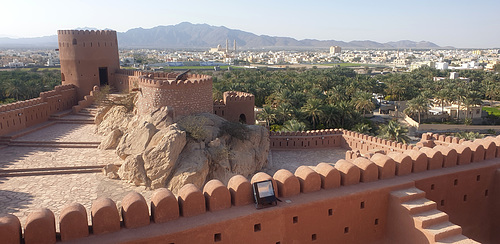
Nakhal Fort
19th century fort, overlooking the local date plantations.
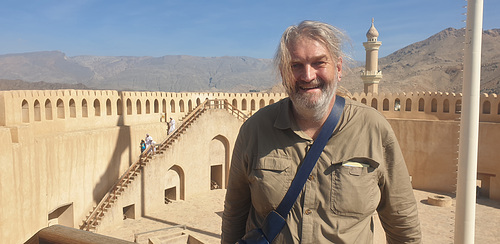
Inside Nizwa Fort
Inside the inner fortifications of Nizwa Fort. This is a 17th century fort, the inner stronghold of a much larger castle. Entrance to the fort was protected with multiple secret trap doors and pitfalls, reinforced doors where boiling date oil could be poured on enemy attackers, and many other impressive defensive components.
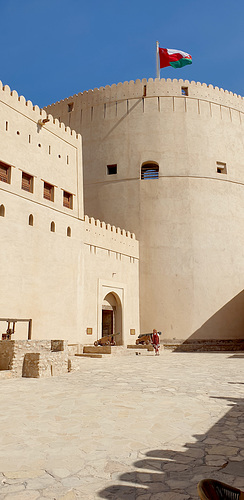
Nizwa Fort's Destinctive Tower
At 40m high, it would make quite the formidable task for any army of that day to consider.

Bahla Fort
One of the largest forts in Oman. Rooms here were generally left empty and unlabelled, allowing the visitor to be creative and hypothesise as one scrambled in and out and around the multitude rooms and the Escher like stairways.

Bahla Fort Interior
Built and modified over the 12th to 15th centuries. The mud-brick walls, as well as the architecture and layout, looked and felt quite different to the other forts we have visited so far in Oman. Not less refined, but they certainly did not feel as evolved.
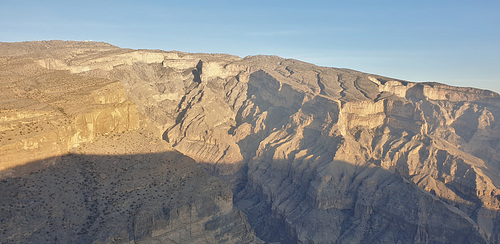
Wadi Ghul Viewpoint
Looking down in to Wadi Ghul from the top of Jebel Shams. This canyon is often called the "Grand Canyon of Oman", and a deserved title it is indeed.
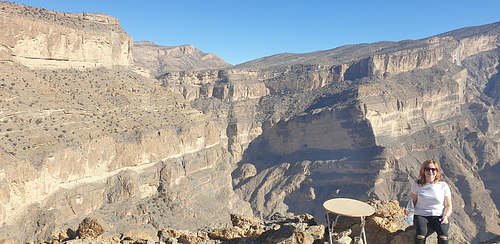
A Stop on the Balcony Walk
The balcony walk is a 5-6 km trail that runs in to Wadi Ghul. It is reasonably level, and although narrow in parts, never precipitous. Doing it in the morning meant we basically were in the sun for the majority. This lookout point seems to occasionally operate as a cafe, with two tables, although there was nobody when we came through. It is reasonably near the end (or start, depending whether you need a break early).
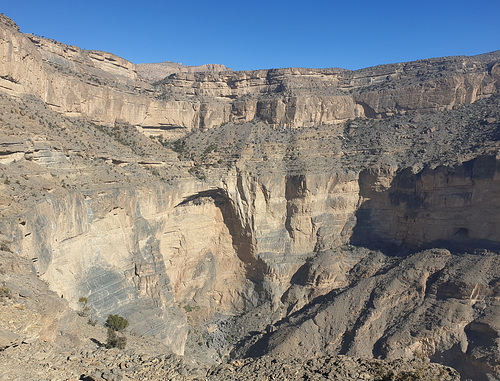
Another View From the Balcony Walk
Deep in Wadi Ghul, Oman's Grand Canyon.
Then east, rapidly loosing altitude, till it was a pleasant 27 degrees by the coast. Circling back to the north, we finished with a coupld of days in Muscat.

Beehive Tombs, Al Ayn
Some of the beehive tombs of Al Ayn, lined along a ridge. Dotted at various sites in the area, they are believed to be between 4000 and 5000 years old.
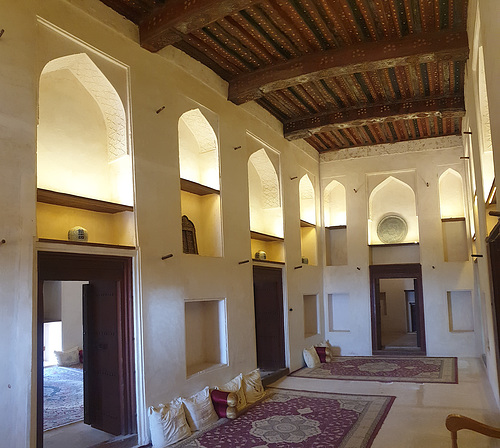
Inside Jabrin Castle
We both felt that Jabrin Castle was our favourite in Oman. The size and layout made for an excellent visit, and a good quantity of information. The furnished rooms, just lovely, and the painted ceilings are especially noteworthy.
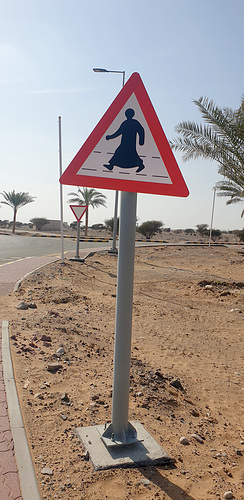
Culturally Appropriate Signage
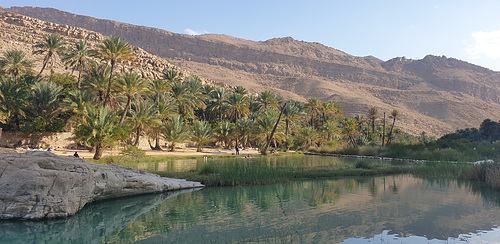
By the Lake, Wadi Bani Khalid
I had read about this location, but when it featured on the plane in Oman Air's in-flight safety video, I was inspired to upgrade it from "maybe" to "must do".

Chai by the Water
Although not visible in the shot, in this lake, and further upstream, families swam and played. It was joyful, listening to the chatter and laughter, children squealing with delight, adults calling and joking.
We didn't swim. Just drank chai and absorbed the atmosphere.
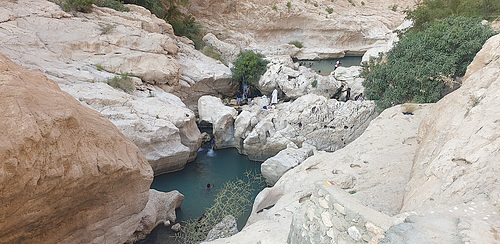
Deeper in Wadi Bani Khalid
Further up the wadi, the rock pools of various sizes were also inhabited by paddlers and swimmers.
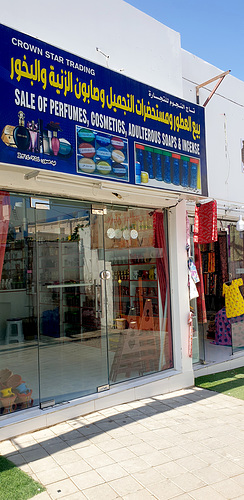
Hmm, Adulterous Soap
A shop sign in the ladies souk in Sur.
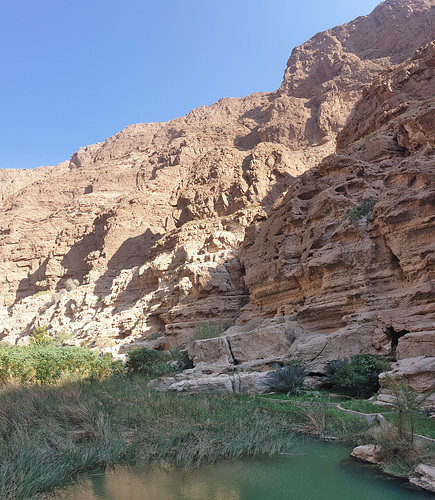
Wadi Shab
Getting close to Muscat, we visited Wadi Shab. It seemed to be the most touristy place we have been in Oman, with many nationalities seemingly represented amongst those heading up. First, there was a boat trip across a smal "lake" from the car park, then on foot, past ancient water channels that are still maintained, modified, and important.
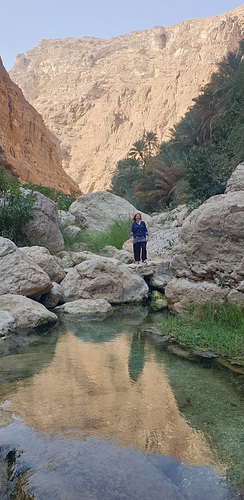
On our Walk, Wadi Shab
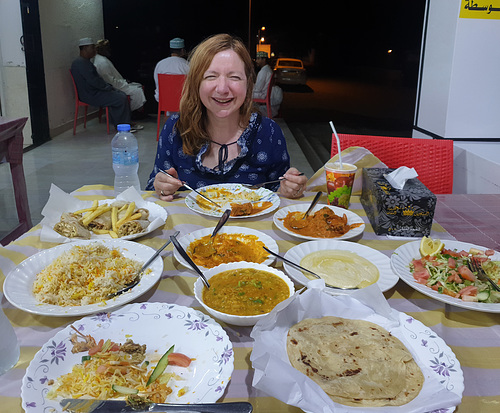
We Ordered Too Much
So, we knew we were ordering more than we needed. We forgot they would automatically give the rice, salad, pita, dahl, and hummus.
The prawn masala was excellent, but the chicken nashif was out of this world.
Old Muscat Gate
Unusually, Old Muscat is not at the heart of Muscat city. What tends to happen, is the historic heart remains the heart of the city, to some degree or another. A new centre may spring up, but the new city surrounds and engulfs the old city.
Muscat, though, has its new city along the coast. Kind of bumped against the old city, but then sprawled out away from it for the next 20 or more kilometres.

































